In manga and anime, "motion lines," dousen 動線, are lines used to show the motion of an object. They're particularly used in manga to make otherwise static panels appear dynamic.
Trajectory Lines
The basic type of motion lines are those used to show the trajectory of objects by depicting their afterimage.
- Context: Naruto ナルト fights Kakashi カカシ.
- In the first panel, Kakashi quickly squats to evade Naruto's kick.
- We know this because of the vertical lines were drawn over Kakashi.
- Without them, Kakashi would be just sitting there for a while and then Naruto just kicks the air for some reason.
Turning Lines
One common, specific kind of trajectory line are those drawn like curves when something turns around. Usually, they're drawn when a character turns their head to look at something.
- Context: Kurumizawa Satanichia McDowell 胡桃沢=サタニキア=マクドウェル makes sure she's not being seen by anyone.
- chira chira
ちらちら
*glancing around*
- Context: Kenshirou ケンシロウ asks a girl how is life.
- .........tsurai ka......
・・・・・・・・・つらいか・・・・・・
Is it tough? - *shakes head*
- kubi wo yoko ni furu
首を横に振る
To shake [one's] head horizontally. (a gesture that means "no.") - kubi
首
Neck. (can also mean head in some cases.)
- kubi wo yoko ni furu
An example of turning lines over the whole body:
- Context: a perverted demon dances.
- oppai♬ ooo♬ oppai
おっぱい♬ おおお♬ おっぱい
Boobs♬ boo... boobs.
Walking Smoke
Although rather dated, in some cases smoke or dust is drawn to symbolize a character's walking steps.
Speed Lines
The "speed lines," or supiido-sen スピード線, are lines drawn on the background to express a sense of speed. These are also called ryuusen 流線, "flow lines."
Besides the lines on the background, sometimes lines are drawn over a character, in some cases replacing their contour, in order to make them look like they're blurring from moving quickly.
- hayai!
速い!
[He] is fast!
Explosion Lines
Motion lines drawn from a center point to all corners of a panel are used to depict a strong impact or other powerful force, like an explosion.
Note, however, that most of the time this sort of effect doesn't depict movement in manga, but focus or emphasis instead. These would be called "focus lines," shuuchuu-sen 集中線, instead.
Camera Lines
Some lines drawn on the background of panels represent not the movement of objects inside the panel, or the movement of the background, but the movement of the camera looking at the scene.
Naturally, there's no actual camera. It's a not a film. It's a panel. But the scenes drawn on those panels are being seen through the perspective of something, the perspective of the narrator, the narrative perspective. Let's just say that perspective is the camera.
To have a better idea of how the motion of the camera is represented in manga, an example:
- Context: Edward Elric エドワード・エルリック uses alchemy to knot a gun.
- uo!?
うお!?
Oof!?- In this panel, lines make the edges of the panel darker, so the center is brighter and looks like an explosion.
- !? nanja korya!!
!?なんじゃこりゃ!!
What is this!? (emotive right-dislocation.)- In this panel, the character that was previously crouching slightly now stands up straight in surprise, so his head is higher than before.
- Instead of drawing speed lines coming from his chin downwards, the author drew speed lines on the top of panel, indicating that the camera looked upwards to see his face.
- bu!!
ぶ!!
*hurt noises*- In this panel, lines were drawn diagonally in the background, which means the camera either followed Edward's foot going to the bad guy's face, or it's following the bad guy flying away diagonally.
The second panel is layout-wise at the left to the first panel, so the eye of the reader goes left. However, in the scene, the object in the second panel is higher than in the first panel, so the camera goes up.
The lines drawn at the edges of the panels can depict the correct shift of the camera no matter how the panels are laid out in the page.
Stirring Lines
In some cases, lines that look like speed lines are drawn in situations where objects aren't really moving at all. Instead, they express force, excitement, tension, agitation, or other intense feelings of the character.
- Context: you can hear the screaming in these vertical lines.
- kimi wa hiiro ni nareru
君はヒーローになれる
You can become a hero.
- Context: Kamado Tanjirou 竈門炭治郎 attempts to make a gourd explode by blowing air into it.
- The first panel has the so-called "focus lines."
- The second and third panel have vertical lines depicting intense emotion.
- ganbare, ganbare! ganbare
がんばれ がんばれ! がんばれ
[You can do it! Hang in there!] (etc.)- ganbare is the meireikei 命令形 of ganbaru 頑張る.
- ganbaru
頑張る
To put effort. To work hard. To do one's best. To hang in there.
In anime, these are literally drawn moving, even though, again, nothing is moving.
- Actual footage.
Note that vertical lines drawn dripping from the top the panel generally mean the character is feeling down instead. These would be called "dripping lines," tare-sen たれ線.
Wobbling Lines
The "trembling lines," furue-sen 震え線, or "wavering lines," yure-sen 揺れ線, are lines drawn around objects, rather than coming from inside of them, to depict that they're moving around slightly, but staying at the same place.
This includes wobbling, shaking , trembling, and so on.
- In the first pair of panels, a hand turns left and right to let drip the water from the cup.
- In the second pair, a hand manipulates an alarm clock.
- In the third panel, a character's head wobbles as he washes his face.
- Context: Carol Olston キャロル・オルストン plays with Aizawa Tomo 相沢智.
- konkon
コンコン
*the sound foxes make*- She makes a fox sign with her hand, using it as if it was a fox hand puppet.
- gabuu
カブー
*sound effect for biting*- The lines drawn around Tomo's fox hand imply she bit Carol's fox and then moved around.
- kyaa
キャー
*shriek*
These curved contours can also be used to depict an objecting enlarging or shrinking over time.
Shaking Lines
When an object is shaking erratically, the contour is drawn shaky, too. The shakier the contour, the shakier the object is shaking.
- Context: Agatsuma Zenitsu 我妻善逸 trembles with fear.
It's worth noting that there are two types of shaking lines:
- The type that represents motion, movement. Objects shaking. This type is commonly drawn in manga, but not in anime, because the movement can simply be animated in anime.
- The type that represents emotion, feeling. Characters shaking in fear, shock, excitement. This type is commonly drawn EVEN IN ANIME, because it's a symbol for the character's mental state.
Stiff Lines
Usually, trembling lines are drawn as curves, because the object bends and turns around. When the lines are drawn as straight, segmented lines, it depicts some sort of stiff trembling.
This can happen when the object is incapable of bending, like it's made out of metal, for example.
- The lamp post, made out of metal, stiffly trembles as the girl climbs it.
It also happens when characters stiffen up, when they become suddenly tense, or they're putting effort or force into keeping still.
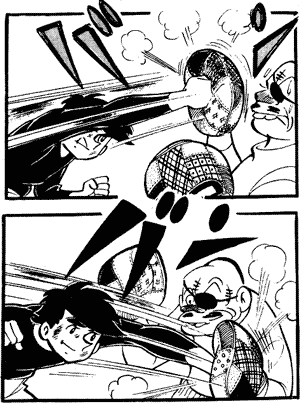
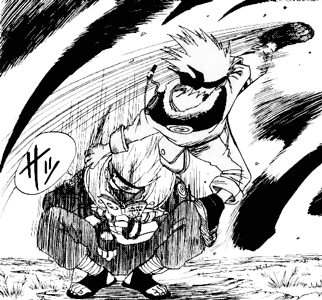
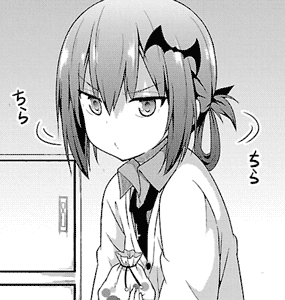
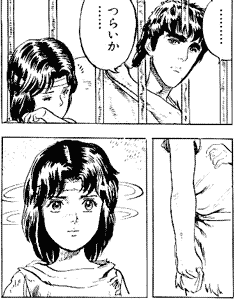

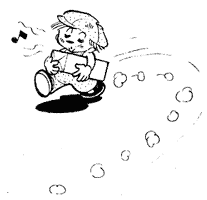


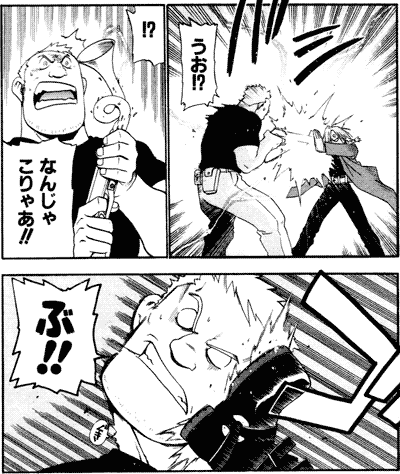
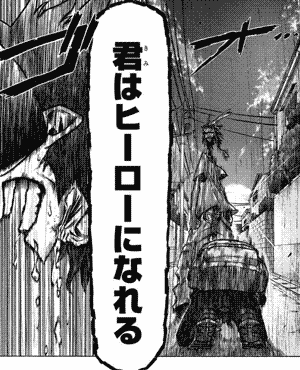
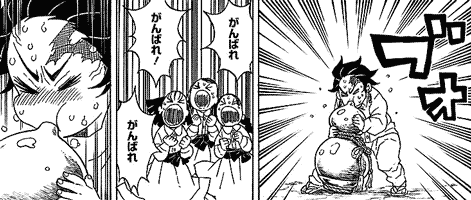
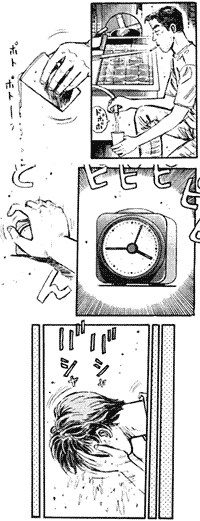
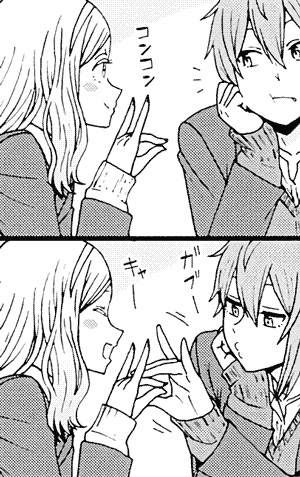

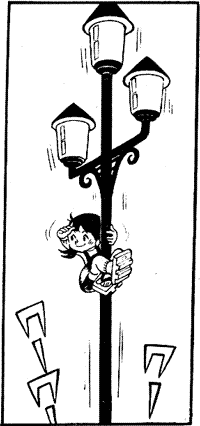
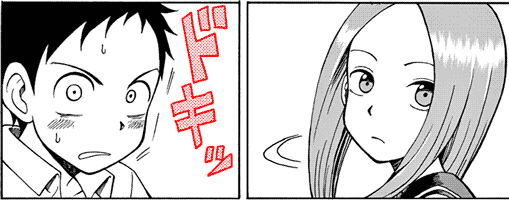
No comments: